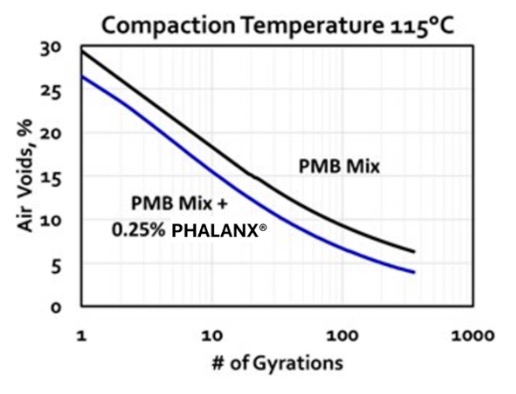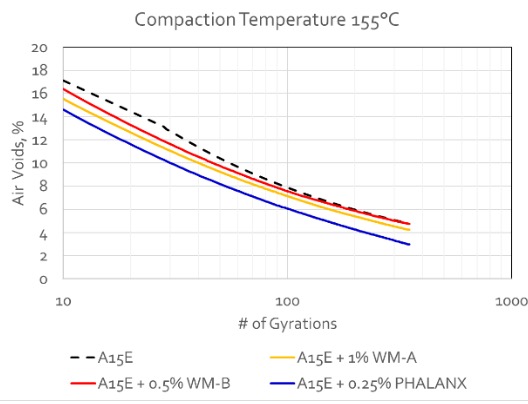Warm mix asphalt (WMA) primarily differs from its hot mix asphalt (HMA) counterpart on the basis of providing for lower asphalt production and compaction temperatures, which can be between 30 to 120°F less than HMA applications. However, WMA offers a number of key advantages over traditional HMAs beyond temperature reduction.
While WMAs are no longer uncommon across the paving industry, some departments of transportation and producers are hesitant to use WMAs. Primary among concerns is whether warm mix asphalt has the capability to remain durable over the long term in comparison to traditional hot mix asphalt (HMA) applications.
Here, we'll take a closer look at the potential benefits and considerations of using WMA technology in roadway paving applications.
The Pros: Warm Mix Asphalt Advantages

Improved Compaction and Workability
Warm mix asphalt use has demonstrated an ability to achieve compaction, density, and air void requirements set by departments of transportation. Dosed with a warm mix additive for asphalt, such as PHALANX®, WMAs can achieve equal, if not superior, compaction compared to HMA mixes, even at lower temperatures. For example, PMB mixes dosed with just 0.25% of PHALANX demonstrated fewer air voids compared to a traditional PMB mix at 115°C. Mix workability is also improved as warm mix additives are believed to improve wettability and reduce friction in a mix.
Reduced Energy Requirements
WMAs can allow for significantly lower production and compaction temperatures compared to HMA. These lower temperatures mean that producers can reduce the amount of energy and fuel needed to heat the product throughout manufacture and application. Studies have shown that WMA mixes can reduce energy consumption by 5-13% with some examples reaching 20%. In turn, these reductions can help lower overall production costs.
Lower Carbon Emissions
Correlated directly with lower fuel consumption is a reduction in carbon emissions. Warm mix asphalt consistently demonstrates decreases in CO2 emissions between 17-23%. Another study found that WMA can lower greenhouse gas (GHG) emissions by 20-35% compared to HMA applications. The majority (92-96%) of total CO2 emissions generated during asphalt production result from the drying and heating of aggregates at the plant. WMA technology's lower temperatures allow for a decrease 2.9kg CO2 per ton of asphalt compared to HMA.
Broadened Paving Seasons
Being able to pave roadway surfaces with lower compaction temperatures also means contractors can operate during an extended paving season that can also include night paving. Typically, larger differences between ambient temperatures and HMA temperatures cause the mix to cool too quickly, often resulting in poorer compaction characteristics and degraded long-term performance. Because WMAs are produced and compacted at lower temperatures, they cool more slowly in comparison to the air temperature. This allows for a longer compaction window, preserves the integrity of the roadway surface, and allows for contractors to pave during months or late hours traditionally prohibitive to quality compaction.
Safer Working Conditions
Working with WMA is likely to be a healthier experience for the production and construction crews working with the materials. Because of their higher temperatures, traditional HMAs produce more smoke, fumes, and dust than when working with WMA mixes. According to the EAPA, reducing compaction temperatures by just 25°C can reduce fume emissions by 75%. The reduction in compaction temperature also results in less hostile and sweltering conditions at the job site. Reduced emissions from WMA implementation also leads to an improvement in air quality for both workers and the surrounding area.
The Cons: Considerations Before Implementing WMA for Asphalt

Plant Production Implications
While lower temperatures offer a variety of benefits, including emissions and energy reductions, producers will need to consider how implementing WMA could impact their plant. For example, burner operation ranges will need to be evaluated to ensure they can accommodate reduced temperatures for drying and heating aggregate. Drying drum rotation speeds and exhaust will also need to be checked since lower temperatures can impact moisture retention.
Environmental Impact of Warm Mix Additives in Asphalt
Warm mix additives may enable production of WMA mixes, resulting in the benefits outlined above, but not all warm mix additives are environmentally friendly. Chemical additives are typically surface-active agents, but their formulation and production processes can vary greatly. Those derived from fossil fuels can have a negative environmental impact.
Choosing an environmentally friendly WMA like PHALANX can help departments of transportation and producers reach their carbon emissions goals throughout the production lifecycle. PHALANX has a global warming potential (GWP) of just 2.99 after cradle to gate assessment and is highly dosage efficient, requiring half or even less compared to other WMAs to achieve superior compaction results.
For more information about PHALANX and how warm mix asphalt in paving can help support sustainability efforts, contact info@sripath.com.
